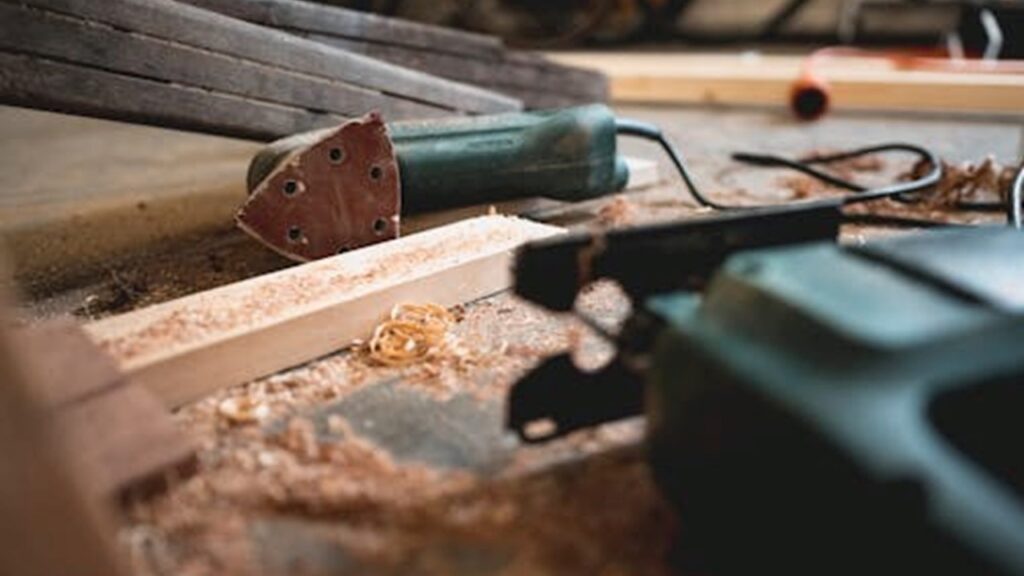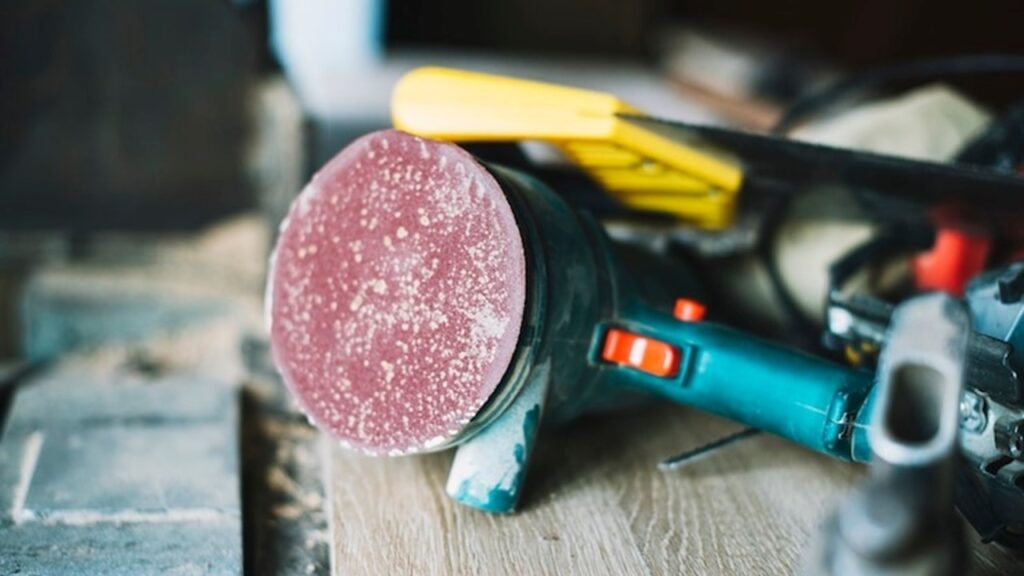
Choosing the right sander can make your DIY or home improvement project a whole lot easier. Whether you are smoothing a wooden table or prepping a wall for paint, there is a perfect sander for the job. But with so many types out there, it can feel overwhelming to pick the right one.
In this beginner-friendly guide, we will break down the most common types of sanders, explain what each one does best, and walk you through the key features to consider before buying.
Understanding the Basics
Before you choose a sander, it helps to understand what the tool actually does and where it fits into different kinds of projects. This section breaks down the basics so you can match the right sander to the job.
What Does a Sander Do?
A sander is a power tool that smooths or shapes surfaces using abrasive sandpaper that moves at high speed. Whether you are preparing a surface for paint, removing old finishes, or evening out rough edges, a sander helps you get the job done faster and with less effort than doing it by hand.
Sanding is all about improving the surface. It can make wood feel soft to the touch, remove paint or varnish, clean up metal before painting, or even shape materials for crafts and DIY projects. Different types of sanders are designed for different jobs, which is why choosing the right one matters.
Types of Surfaces and Projects That Require a Sander
Sanders can be used on more than just wood. Here are some of the most common uses:
- Wood: If you are building or refinishing furniture, sanding is key to getting a smooth, professional-looking finish. Sanders are also used to level floors, prep decks, and clean up trim.
- Metal: Some sanders can remove rust or old paint from metal surfaces. They help prep the metal so paint or sealant sticks better.
- Drywall and Paint Prep: Before painting walls or ceilings, a light sanding can smooth out bumps or leftover joint compound.
- Crafts and DIY Projects: From small shelves to homemade toys, sanding helps give your project a polished look and feel.
Main Types of Sanders and When to Use Them
Choosing the right sander depends on what kind of work you plan to do. Here’s a breakdown of the most common types and what they are best suited for:
1. Belt Sander
Belt sanders are powerful tools that use a loop of sandpaper stretched over two drums. They are great for quickly removing a lot of material.
This makes them perfect for leveling hardwood floors, sanding down rough boards, or stripping paint from large flat surfaces. Because they are aggressive, they are not ideal for fine finishing but great for big jobs.
2. Orbital Sander (Sheet Sander)
This type of sander moves in small circles and is often used for finish work. Orbital sanders are best for smoothing surfaces and light sanding tasks.
They usually use square or rectangular sheets of sandpaper. While they are not designed to remove a lot of material quickly, they are easy to control and good for beginners.
3. Random Orbital Sander
Random orbital sanders combine the motion of an orbital sander with a spinning movement. This helps reduce visible swirl marks and gives a smoother finish.
They can remove more material than a basic orbital sander but still leave a fine surface behind. These are great all-purpose sanders, especially for woodworking or furniture projects.
4. Detail Sander
Detail sanders have a small, triangle-shaped pad that lets you get into corners and tight spaces. If you are working on furniture with lots of curves or edges, this is the tool to reach for. It is also called a corner or mouse sander. While not made for large surfaces, it is great for fine details.
5. Drum Sander
This is a large, heavy machine mostly used by professionals. Drum sanders are built to sand entire floors and are good at removing deep damage or old finishes.
They can be tricky to use, and if you are not careful, they can leave deep grooves in your floor. Not recommended for beginners, but good to know about if you are planning a big flooring project.
6. Disc and Spindle Sanders
These sanders usually sit on a bench or work table. A disc sander has a flat spinning disc, while a spindle sander has a cylindrical drum that moves up and down.
Both are great for shaping and smoothing edges, especially on curved or oddly shaped pieces. These are common in woodworking shops and are popular for crafts and hobby work.
7. Multi Sander
A multi-sander is a flexible tool that combines features of orbital and detail sanders. It usually has a base shaped like an iron so it can reach corners but still cover more surface area than a detail sander.
It is a great choice for people who want one tool for several types of small to medium tasks.
Key Features to Consider When Choosing a Sander
When picking out a sander, it is not just about the type. Certain features can make your work smoother, faster, and more comfortable. Here are some of the most important ones to keep in mind.
Power Source: Corded vs. Cordless
Corded sanders plug into the wall and give you steady power for as long as you need. They are great for big projects where you will be working for long stretches. You never have to worry about charging a battery, and they often have more power.
Cordless sanders run on batteries, which gives you the freedom to move around without being tied to an outlet. These are ideal if you are working in different spots or on a jobsite. The downside is that battery life can limit how long you work, so having a spare battery is a good idea.
Choose a corded model if you plan to work in one area with access to power. Go cordless if you need flexibility or are often on the move.
Speed Settings
Some sanders come with variable speed control, while others have a fixed speed. Variable speed lets you slow down or speed up the sanding depending on what you are working on. Slower speeds are useful for delicate tasks, while higher speeds are good for removing material quickly.
If you are just doing basic tasks, a single-speed model may be enough. But if you want more control for different types of projects, variable speed is worth it.
Dust Collection
Sanding creates a lot of dust, and if you are working indoors, it can become a mess quickly. Most sanders come with built-in dust bags, and some have ports that connect to a vacuum.
Using a vacuum setup is more effective for keeping your work area clean and protecting your lungs from fine dust. If dust control is important to you, choose a model with a good dust collection system.
Ergonomics and Grip
If you plan to use your sander for more than a few minutes at a time, comfort matters. Look for soft rubber grips and good balance in the tool. Some sanders also have extra handles for better control.
A tool that is too heavy or awkward can cause strain. The easier it is to hold and control, the better your results will be.
Sandpaper Attachment Style
There are two common ways sandpaper attaches to sanders: hook-and-loop (like Velcro) or clamps.
Hook-and-loop systems are fast and easy. You just press the paper on and peel it off when done. Clamps take a little more time but work well too, especially on basic sheet sanders.
Make sure you can easily find the right type and size of sandpaper for the sander you choose.
Choosing the Right Sander for Your Project
Still unsure which sander fits your task? Here is a quick guide to match sanders with the work you are doing.
- For light sanding or finishing touches, go with a palm sander or orbital sander.
- If you are removing paint or varnish, a random orbital sander will give you a clean finish without swirl marks.
- For leveling large, rough surfaces, a belt sander or drum sander is the way to go.
- When working on tight corners or curves, choose a detail sander or a spindle sander.
- If you want a tool that handles a bit of everything, a multi-sander is a solid choice for most DIY jobs.
Understanding Sandpaper Grits
Sandpaper comes in different grit levels, which tells you how coarse or fine it is. The lower the number, the rougher the sandpaper. The higher the number, the smoother the finish.
- Coarse grits (40 to 60) are used to remove old paint, shape wood, or clean up very rough surfaces.
- Medium grits (80 to 120) are great for general sanding and surface prep.
- Fine grits (150 and above) are used for finishing work, like smoothing before painting or applying a finish.
For best results, start with a coarse grit to remove material, then work your way up to a finer grit for a smooth finish.
Safety Tips for Using a Sander
Using a sander is usually safe, but it is still a power tool. To avoid injury or damage, always follow these simple safety tips.
- Wear protective gear. Always use safety goggles to protect your eyes from flying dust and debris. A dust mask or respirator helps keep fine particles out of your lungs. Ear protection is also a good idea, especially if you are sanding for a long time.
- Secure your material. Make sure the piece you are sanding is firmly clamped or held in place. This helps prevent slipping and gives you more control over the tool.
- Never leave a running sander unattended. Always turn off the sander and unplug it or remove the battery if you need to step away, even for a short moment.
Taking these precautions will keep you safe and help you get better results on your project.
Final Tips Before You Buy
Before you choose a sander, here are a few last things to think about.
- Stick with trusted brands. Companies like DEWALT, Bosch, Makita, and Milwaukee are known for reliable tools and solid customer support.
- Check the warranty. A good warranty can save you money if something goes wrong. Look for clear return policies and accessible service options.
- Read user reviews. Real feedback from other buyers can tell you a lot about how a sander performs in everyday use.
- Think long term. Choose a sander that not only fits your current project but also works for future tasks as your skills grow.
Taking your time to choose the right tool will pay off in the long run.
Conclusion
Choosing a sander does not have to be confusing. Start by knowing what type of work you will do, then match the right type of sander to the job. From there, look at the key features that matter most, like power source, dust collection, and grip comfort.
A good sander makes your work smoother, faster, and more enjoyable. Whether you are a complete beginner or just getting back into DIY projects, the right sander can make a big difference. Take your time, think through your options, and pick the one that fits your needs best.

At our core, we’re a group of passionate sanding and polishing equipment enthusiasts. We dive deep into the world of any type of sander and polisher around us. We try to provide as much value to the readers with our information and how to blog articles as possible along with proper information-based reviews as well.




